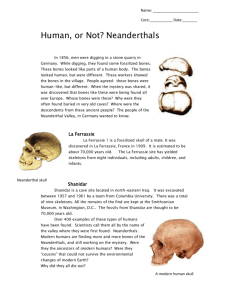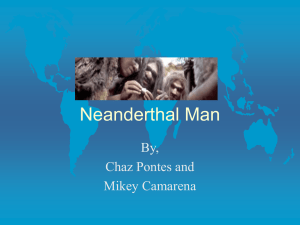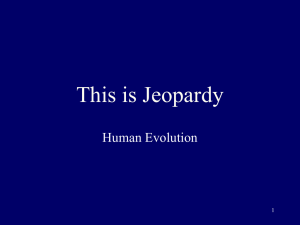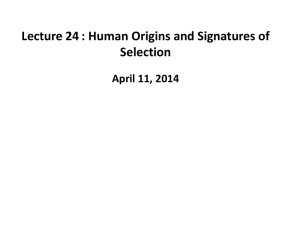Neanderthal burial (with questions)
advertisement
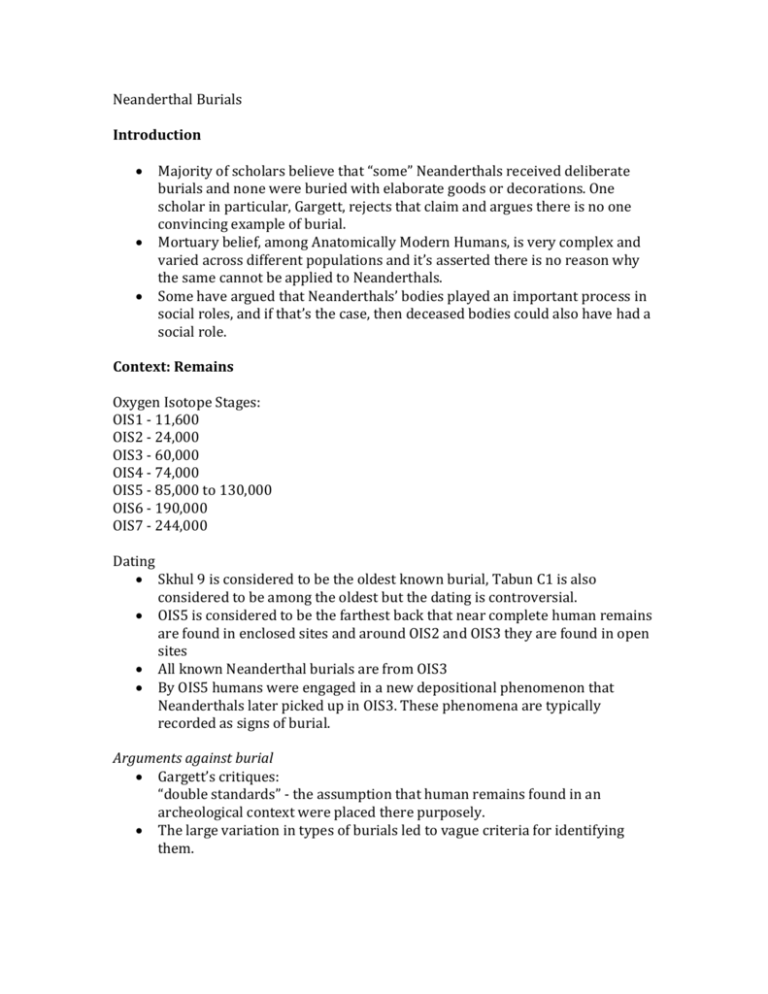
Neanderthal Burials Introduction Majority of scholars believe that “some” Neanderthals received deliberate burials and none were buried with elaborate goods or decorations. One scholar in particular, Gargett, rejects that claim and argues there is no one convincing example of burial. Mortuary belief, among Anatomically Modern Humans, is very complex and varied across different populations and it’s asserted there is no reason why the same cannot be applied to Neanderthals. Some have argued that Neanderthals’ bodies played an important process in social roles, and if that’s the case, then deceased bodies could also have had a social role. Context: Remains Oxygen Isotope Stages: OIS1 - 11,600 OIS2 - 24,000 OIS3 - 60,000 OIS4 - 74,000 OIS5 - 85,000 to 130,000 OIS6 - 190,000 OIS7 - 244,000 Dating Skhul 9 is considered to be the oldest known burial, Tabun C1 is also considered to be among the oldest but the dating is controversial. OIS5 is considered to be the farthest back that near complete human remains are found in enclosed sites and around OIS2 and OIS3 they are found in open sites All known Neanderthal burials are from OIS3 By OIS5 humans were engaged in a new depositional phenomenon that Neanderthals later picked up in OIS3. These phenomena are typically recorded as signs of burial. Arguments against burial Gargett’s critiques: “double standards” - the assumption that human remains found in an archeological context were placed there purposely. The large variation in types of burials led to vague criteria for identifying them. Since there were more fragmentary remains in the Upper Pleistocene of Neanderthals than Modern Humans, it is assumed that the few complete skeletons were deliberately buried. More recent burial interpretations have been more conservative due to dubious sites being eliminated from a larger critique. Ex. Krapina site - Cannibalism Estimates of burials 34 to 36 over 16 sites More inclusive number at 60 12-14 in Europe, 20 in Western Asia 20 in Europe, 12 in Near East Overall, number varies from 32-60 among scholars Rebuttal to Gargett Gargett has been criticized for questionable readings of data Critique of five questions asked: 1. What constitutes evidence of purposeful protection of the corpse? - Gargett criticizes criteria for recognizing burial when looking at Neanderthal remains - unless there is a new stratum, there is no way to know if burial took place. - However, graves are dug into and covered with the same pre existing strata - 2. What is the probability of natural burial in caves and rock shelters? Gargett asserts that, at certain sites, materials could have accumulated against cave walls and rock shelters, and under those circumstances, bones could have been better preserved. This explanation doesn’t take into account extreme weather (floods, mud flows) or carnivores that dig or burrow. Data from actual sites does not indicate the dense accumulation of debris. Denning carnivore remains do not show up as frequently as one would expect if accumulated materials aided in preservation. Burials in central locations 1. Roc de Marsal - child near center of cave 3m from mouth 2. Amud 1 - near complete skeleton 4m from wall, directly below cave underhang 3. Kebara 2 - adult male in central area named decapage, where the evidence of clusters of hearths was most dense. There were large amounts of mammal bones. 3. What is the prior probability of preservation under any circumstances? - Gargett suggests that out-of-the-way places such as natural depressions in caves should carry equal weight in explaining the preservation of Neanderthal - - remains, and that unless these places were artificially designed for the sole purpose of burying a body, they are not convincing evidence for burial. Argument ignores the practicality of using natural depressions for burial and the fact that areas originally serving another purpose, such as storage of food, may also eventually function as a grave. 4. What is the importance of articulation? All things being equal, the species dying more in enclosed sites would preserve more skeletons. The large amount of skeletal remains of earlier hominids suggests that later ones simply spent less time in caves than Neanderthals. Enclosed sites dating back to before OIS5 contain evidence of lithic and fauna activity, which indicate the presence of hominids. Depositional factors have remained similar in enclosed sites in Lower, Middle, and Upper Paleolithic. Humans do not always bury their dead on habitation sites. Little to no evidence of Upper Paleolithic communities, who used caves far more than Neanderthals, ending up being preserved in natural features. 5. What is the variability in the rates of decomposition, disarticulation sequences, and the likelihood of disturbance? - Majority of Middle Paleolithic hominid remains succumbed to physical disturbance. Attempts to account for missing anatomical elements. La Chapelle-aux-Saints - Near complete adult skeleton in roughly rectangular depression. - Gargett rejects example because at the time of the burial, the ceiling was very low and would have required crawling, a carnivore’s den seems more likely. - Many examples of low spaces containing activity such as art, so low ceiling is likely not a problem. - In the stratum containing the remains, there was evidence of Neanderthal activity. - Likelihood of naturally formed rectangular pit under karstic shelter is incredibly low. La Ferrassie rockshelter - Seven Neanderthal skeletons, two are almost complete located near back of shelter - Gargett suggests that the remains being located near the back was most likely the reason for preservation - At least two of the pits are likely to have been artificially excavated by Neanderthals - The mounds under the rock shelter are very likely natural formations rather than funeral markers. Shanidar, Iraq - About as far back as 45-60ka BP, over the span of 15ka, about ten Neanderthal remains were deposited in a cave. - Unlikely due to ceiling collapse as Gargett has argued. - Flowers originally thought to be purposely placed over one corpse for ceremonial reasons - Markers such as limestone or group memory of the location may have been in operation when depositing the bodies in the cave over the long period of time. If there were burials of Neanderthals, they were rare and varied, and it would be incorrect to view these activities as one type of “burial” phenomenon. Assuming removing dead from occupied sites was an important activity, probably because it reduced attracting predators and bacteria, then the presence or absence of remains tells us how much control over the situation Neanderthals had at the time. When in control, Neanderthals carefully removed bodies from sites, but burials was very likely not their main means of disposal. The dead of the Paleolithic Six deliberate mechanisms for disposal of human bodies (5 may be relevant to Neanderthals): 1. Non-burial means of disposal - burial is not always the typical means of burying a corpse in the ground. This type does no preserve bones well and is not relevant to Neanderthals. 2. Caching of bodies or body parts - deliberate placement of bodies or parts of them in unmodified locations in environment with little to no effort in modifying the environment. Potentially includes remains at Sima de los Huesos at Atapuerca Spain, Pontnewydd in Wales, and Krapina in Croatia. 3. Simple inhumation, apparently without grave goods (OIS5) - placement of body in excavated feature such as a grave. Includes some Neanderthal as well as AMH burials in Taramsa Egypt, Skhul and Qafzeh Israel, and Lake Mungo 3 in Australia. 4. Elaborated primary activity - placement of body in excavated feature, with addition of attitude towards body (tight flexion) and/or grave goods. Also marking of grave with either information (tradition) or physical marker. 5. Elaborated secondary activity - defleshing activities and/or subsequent burial. This can also be re-excavation and removal of bodies. 6. Ritualized burial - more formalized version of elaborated primary activity involving formalized placement of goods, bodily ornamentation, marking of grave, and emplacement of later individuals in pre-existing grave cuts. No evidence of this category until 27ka BP (mid/upper Paleolithic). Caching the dead: origins of mortuary ritual Sima de los Huesos >32 individuals from 200-300 ka BP recovered from shaft deposits Comprised mostly adult Homo heidelbergensis with physical features foreshadowing European Neanderthal Breakages on bones too great to account for fall down shaft, possible postdepositional movement and carnivore activity. Accumulation materials could be man-made and suggests placement of bodies in a cave close to shaft. However, shaft could have opened up to light and would have had different depositional phenomenon than what is seen now and age distribution of remains cannot rule out natural deposition. Pontnewydd Cave, Wales 5-15 Neanderthals remains before 225 ka BP in OIS7 Mostly males under age of 20 Unlikely for carnivores to deposit such a large amount La Quina Excavation of mostly cranial elements One contains many bones of the upper body and lacks carnivore marks Could have been a cache around mid OIS3 Krapina, Croatia Most compelling evidence for secondary processing (defleshing) and caching. Proliferation of high fragmentary bones Cut marks on many bones indicates defleshing Simple Inhumation Kebara Cave, Israel Excavation of a grave cutting of an adult Neanderthal The body decomposed in a filled grave based on evidence from the strata. The sediment of the pit was easily distinguishable from the sediment into which the pit was dug. The skeleton was lying on its back and the cranium was absent. Carnivore removal was ruled out because other relevant parts were in correct anatomical position. The purposeful removal of the cranium appears to be the fist case, in a Mousterian context, for later human intervention in a burial. This indicates elaborated secondary activity. Amud Cave Complete adult Neanderthal skeleton in central position of cave lying on its left side. High animal and hominid activity, including hominid excavation of pits. When spatial information on remains is available, looking at potential burials can be questionable, especially if remains are in an unnaturally tight cluster: Le Moustier - Adolescent found in lower shelter, possibly buried. - Body was lying on right side, but confined space makes burial open to question. Teshik Tash, Uzbekistan - Adolescent boy’s partial remains found in restricted spatial area formed along with small limestone eboulis. Unconvincing indication of burial. La Quina - 22 individuals in total, only 4 teeth were in articulation Primary and Secondary Activity Stone tool cut marks found on numerous Neanderthal bones indicate that, on occasion, Neanderthals processed soft tissues of the dead. Most claims for cannibalism have now been interpreted as de-fleshing. Moula Guercy Cave - Signs of cannibalism in many of the bone fragments recovered - Cut marks and impact scars, indicative of de-fleshing before smashing with a hammer stone and anvil. - Treatment of the bodies parallel de-fleshing in many ways aside from the smashing of the bones. - Cut marks reveal severing of tendon and temporalis muscle, which are consistent with de-fleshing. - More convincing evidence of cannibalism involve removal of tongue, removal of thigh musculature, and possible disarticulation of shoulder on other individuals. - Conflicting evidence has yet to be resolved. Kebara 2 - potential secondary removal of head after it decayed. La Ferrassie - evidence suggests that infant buried in pit was decapitated and had its face removed. Remains at Krapina and Engis, Belgium also show cut marks and signs of defleshing. Pits Regardless of reasoning behind the removal of soft tissue, evidence shows that at least some Neanderthals showed interest in the dead. In La Ferrassie, three bowl shaped pits containing one individual each were excavated. Another natural pit contained the partial skeleton of a child, covered with a limestone block with circular impressions, probably made by a Neanderthal. Pit burial has been suggested on poor evidence: Irregular pit in La Quina, only two human teeth recovered on edge of pit suggested as burial. A pit dug into at Combe Grenal was suggested as being a grave even though there were no remains in it. The reasoning was that it must have contained a small child and that children’s bones are more delicate thus being more susceptible to decay, although this doesn’t explain why tougher bones such as teeth were not present. Le Moustier - near complete remains of an infant in a small pit, one of three, the other two pits were empty. Evidence shows pit was purposely dug but not if the pit was dug solely for the purpose of containing a body. Dederiyeh Cave - Two infant burials (OIS3), the first was in excellent condition, with high degree of articulation, the second was filled with fine grain sediment and buried with numerous flints, stone flakes, and animal fragments. Three hypotheses to explain this feature: Hypothesis A - the pit was excavated and an infant, at some stage, was laid in it. Geological or animal activity disturbed the body and some parts were removed. Stone tools and fragments may have been grave goods or ended up in pit by accident. Hypothesis B - A pit was excavated and at some point the remaining parts of a corpse originally laid elsewhere were laid within it with some respect for anatomical positioning. Hypothesis C - the pit was used to remove things from the floor of the cave such as stone tools and animal parts. A Neanderthal corpse happened to be among the things. Assuming the first hypothesis would seem implausible because of the missing parts. Entire thorax is missing while leaving behind rib and vertebral parts. The inclusion of animal bones and stone fragments as ceremonial is also unlikely. Hypothesis B seems most likely correct due to somewhat correct anatomical positioning. It may have been that the infant was deposited with some concern in a shallow pit that may have already had animal bones and stone shards in it, and there was no concern to remove the materials. If hypothesis C were correct, one would expect more disarticulation of the bones. Mezmaiskaya Cave - 24 cranial fragments of 1-2 year old Neanderthal found in shallow pit covered by limestone block. Uncertain if artificial or natural in origin. - Despite high amount of skull fragmentation, it seems unlikely that a block of limestone could have created a pit naturally, pointing to deliberate deposition. The high number of infants found in small semi-circle shaped pits it not surprising, because the number of uses these pits likely served (hearths, storage, etc.) may have also been convenient for burying small bodies. Mortuary centres A small number of sites were exceptional at preserving multiple inhumations such as Skhul. Three categories of multiple individual recovery: 1. Human bodies were being cached in or by entrances to caves as early as OIS7. 2. From OIS5, a small number of sites preserve highly fragmentary remains of large numbers of Neanderthals. These sites could have been were bodies were processed in mortuary ritual. Cut-marked Neanderthal bones are extremely rare and that may indicate that Neanderthals were not simply engaging in mundane de-fleshing activities. 3. From late OIS5, a small number of sites have preserved near complete remains of several individuals. - Nine in Shanidar, five of which were buried, speculation that limestone blocks over the graves are markers. Other examples: - L’Hortus site contained at least 20 individuals, young adult age - At Krapina site at least 25 individuals represented by fragmentary remains - At least 22 fragmentary individuals at La Quina - Seven at La Ferressie, three newborns, two children, and two adults Regardless of the type, its clear that these caves served a mortuary function that extended past the life of a single individual. At Shanidar, the cave was used continuously over a long period of time. This evidence suggests that some transmission of mortuary tradition was passed on through generations, focusing on suitable locations to process and bury the dead. Grave offerings and mortuary variability Although scholars have forwarded many examples of grave goods, none are convincing because the objects inside the grave cuts never differ from the objects found in the sediment above the graves. Examples: La Ferrassie 5 - supposed placement of three flints, but too many similar artifacts around site to assert deliberate offerings. La Chapelle-aux-Saints - long bovid bones, several flint artifacts, and articulated reindeer vertebrae found in graves proximity. These items were found above head and the area in general contained a plethora of fauna and lithic remains, which indicates these were not deliberately placed. Currently, there are no convincing examples of grave good placement. The lack of goods doesn’t deter the notion that the dead played a social role in Neanderthal society. Grave goods typically indicate notions of self-expression and ownership. The lack of any goods suggests that objects were only important for their immediate physical function. Implications and conclusion Some scholars have suggested that pre OIS5 humans have used areas of the landscape to dispose of the dead without artificial modification. Up to 30 indications of simple inhumation exist for Eurasian Neanderthals. All examples of the inclusion of grave goods for Neanderthal burials are open to simpler explanations and there is currently no convincing example of grave goods. Occasional secondary processing occurred at certain sites, but was not common. While there is certainly some evidence of Neanderthal burial, it’s important not to make broad statements like “Neanderthals buried their dead”. Neanderthal burial may have been just a brief phenomenon in the course of their history of dealing with the living and the dead. Questions: 1. What are Pettitt’s responses to Gargett’s five questions about Neanderthal burials? 2. What does the cave in Shanidar, Iraq tell us about Neanderthal burials? 3. Pettitt lists six types of burials, which ones did he believe Neanderthals engaged in? Give an example of each. 4. When discussing a pit containing an infant at Dederiyeh Cave, Pettitt comes up with three hypotheses in explaining their origins. Which hypothesis does he find most plausible and why? 5. Cannibalism among Neanderthals is a controversial issue. Discuss the evidence for and against cannibalism and include the role de-fleshing might have played in the interpretation of the evidence.

